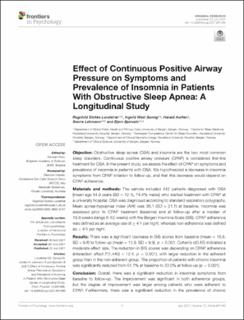| dc.contributor.author | Lundetræ, Ragnhild Stokke | |
| dc.contributor.author | Saxvig, Ingvild W. | |
| dc.contributor.author | Aurlien, Harald | |
| dc.contributor.author | Lehmann, Sverre | |
| dc.contributor.author | Bjorvatn, Bjørn | |
| dc.date.accessioned | 2022-01-31T12:31:13Z | |
| dc.date.available | 2022-01-31T12:31:13Z | |
| dc.date.created | 2022-01-18T09:49:57Z | |
| dc.date.issued | 2021 | |
| dc.identifier.issn | 1664-1078 | |
| dc.identifier.uri | https://hdl.handle.net/11250/2975977 | |
| dc.description.abstract | Objective: Obstructive sleep apnea (OSA) and insomnia are the two most common sleep disorders. Continuous positive airway pressure (CPAP) is considered first-line treatment for OSA. In the present study, we assess the effect of CPAP on symptoms and prevalence of insomnia in patients with OSA. We hypothesized a decrease in insomnia symptoms from CPAP initiation to follow-up, and that this decrease would depend on CPAP adherence.
Materials and methods: The sample included 442 patients diagnosed with OSA [mean age 54.9 years (SD = 12.1), 74.4% males] who started treatment with CPAP at a university hospital. OSA was diagnosed according to standard respiratory polygraphy. Mean apnea-hypopnea index (AHI) was 30.1 (SD = 21.1) at baseline. Insomnia was assessed prior to CPAP treatment (baseline) and at follow-up after a median of 19.9 weeks (range 6–52 weeks) with the Bergen Insomnia Scale (BIS). CPAP adherence was defined as an average use of ≥ 4 h per night, whereas non-adherence was defined as < 4 h per night.
Results: There was a significant decrease in BIS scores from baseline (mean = 18.8, SD = 9.8) to follow-up (mean = 12.9, SD = 9.9), p < 0.001. Cohen’s d(0.65) indicated a moderate effect size. The reduction in BIS scores was depending on CPAP adherence (interaction effect F(1,440) = 12.4, p < 0.001), with larger reduction in the adherent group than in the non-adherent group. The proportion of patients with chronic insomnia was significantly reduced from 51.1% at baseline to 33.0% at follow-up (p < 0.001).
Conclusion: Overall, there was a significant reduction in insomnia symptoms from baseline to follow-up. The improvement was significant in both adherence groups, but the degree of improvement was larger among patients who were adherent to CPAP. Furthermore, there was a significant reduction in the prevalence of chronic insomnia at follow-up compared to baseline. This suggests that CPAP effectively reduces both the presence of insomnia and the severity of insomnia symptoms in some patients with OSA. | en_US |
| dc.language.iso | eng | en_US |
| dc.publisher | Frontiers Media | en_US |
| dc.rights | Navngivelse 4.0 Internasjonal | * |
| dc.rights.uri | http://creativecommons.org/licenses/by/4.0/deed.no | * |
| dc.title | Effect of Continuous Positive Airway Pressure on Symptoms and Prevalence of Insomnia in Patients With Obstructive Sleep Apnea: A Longitudinal Study | en_US |
| dc.type | Journal article | en_US |
| dc.type | Peer reviewed | en_US |
| dc.description.version | publishedVersion | en_US |
| dc.rights.holder | Copyright 2021 Lundetræ, Saxvig, Aurlien, Lehmann and Bjorvatn. | en_US |
| dc.source.articlenumber | 691495 | en_US |
| cristin.ispublished | true | |
| cristin.fulltext | original | |
| cristin.qualitycode | 1 | |
| dc.identifier.doi | 10.3389/fpsyg.2021.691495 | |
| dc.identifier.cristin | 1983211 | |
| dc.source.journal | Frontiers in Psychology | en_US |
| dc.identifier.citation | Frontiers in Psychology. 2021, 12, 691495 . | en_US |
| dc.source.volume | 12 | en_US |

